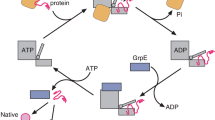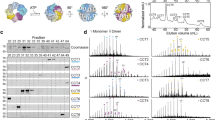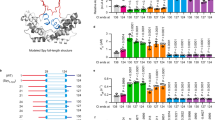Abstract
PROTEIN folding by the double-ring chaperonin GroEL is initiated in cis ternary complexes, in which polypeptide is sequestered in the central channel of a GroEL ring, capped by the co-chaperonin GroES1–3. The cis ternary complex is dissociated (half-life of ˜15 s) by trans-sided ATP hydrolysis, which triggers release of GroES4–6. For the substrate protein rhodanese, only ˜15% of cis-localized molecules attain their native form before hydrolysis2,7. A major question concerning the GroEL mechanism is whether both native and non-native forms are released from the cis complex. Here we address this question using a 'cis-only' mixed-ring GroEL complex that binds polypeptide and GroES on only one of its two rings. This complex mediates refolding of rhodanese but, as with wild-type GroEL, renaturation is quenched by addition of mutant GroEL 'traps', which bind but do not release polypeptide substrate7,8. This indicates that non-native forms are released from the cis complex. Quenching of refolding by traps was also observed under physiological conditions, both in undiluted Xenopus oocyte extract and in intact oocytes. We conclude that release of non-native forms from GroEL in vivo allows a kinetic partitioning among various chaperones and proteolytic components, which determines both the conformation and lifetime of a protein.
This is a preview of subscription content, access via your institution
Access options
Subscribe to this journal
Receive 51 print issues and online access
$199.00 per year
only $3.90 per issue
Buy this article
- Purchase on Springer Link
- Instant access to full article PDF
Prices may be subject to local taxes which are calculated during checkout
Similar content being viewed by others
References
Weissman, J. S. et al. Cell 83, 577–588 (1995).
Mayhew, M. et al. Nature 379, 420–426 (1996).
Weissman, J. S., Rye, H. S., Fenton, W. A., Beechem, J. M. & Horwich, A. L. Cell 84, 481–490 (1996).
Todd, M. J., Viitanen, P. V. & Lorimer, G. H. Science 265, 659–666 (1994).
Burston, S. G., Ranson, N. A. & Clarke, A. R. J. molec. Biol. 249, 138–152 (1995).
Hayer-Hartl, M., Martin, J. & Hartl, F. U. Science 269, 836–841 (1995).
Weissman, J. S., Kashi, Y., Fenton, W. A. & Horwich, A. L. Cell 78, 693–702 (1994).
Fenton, W. A., Kashi, Y., Furtak, K. & Horwich, A. L. Nature 371, 614–619 (1994).
Braig, K. et al. Nature 371, 578–586 (1994).
Boisvert, D. C., Wang, J., Otwinowski, Z., Horwich, A. L. & Sigler, P. B. Nature struct. Biol. 3, 170–177 (1996).
Langer, T., Pfeifer, G., Martin, J., Baumeister, W. & Hartl, F. U. EMBO J. 11, 4757–4765 (1992).
Jackson, G. S. et al. Biochemistry 32, 2554–2563 (1993).
Chandrasekhar, G. N., Tilly, K., Woolford, C., Hendrix, R. & Georgopoulos, C. J. biol. Chem. 261, 12414–12419 (1986).
Viitanen, P. V. et al. Biochemistry 29, 5665–5671 (1990).
Martin, J. et al. Nature 352, 36–42 (1991).
Gray, T. E. & Fersht, A. R. FEBS Lett. 292, 254–258 (1991).
Ellis, R. J. & Hartl, F.-U. FASEB J. 10, 20–26 (1996).
Murray, A. W. in Methods in Cell Biology Vol. 36, 581–605 (Academic, San Diego, 1991).
Shivanna, B. D., Mejillano, M. R., Williams, T. D. & Himes, R. H. J. biol. Chem. 268, 127–132 (1993).
Schroder, J., Langer, T., Hartl, F.-U. & Bukau, B. EMBO J. 12, 4137–4144 (1993).
Buckberger, A., Schröder, H., Hesterkamp, T., Schönfeld, H.-J. & Bukau, B. J. molec. Biol. (in the press).
Kandror, O., Busconi, L., Sherman, M. & Goldberg, A. L. J. biol. Chem. 269, 23575–23582 (1994).
Tandon, S. & Horowitz, P. M. J. biol. Chem. 264, 9859–9866 (1989).
Author information
Authors and Affiliations
Rights and permissions
About this article
Cite this article
Burston, S., Weissman, J., Farr, G. et al. Release of both native and non-native proteins from a cis-only GroEL ternary complex. Nature 383, 96–99 (1996). https://doi.org/10.1038/383096a0
Received:
Accepted:
Issue Date:
DOI: https://doi.org/10.1038/383096a0
This article is cited by
-
Reconciling theories of chaperonin accelerated folding with experimental evidence
Cellular and Molecular Life Sciences (2010)
-
The effect of C-terminal mutations ofHSP60 on protein folding
Journal of Biomedical Science (2002)
-
Distinct actions of cis and trans ATP within the double ring of the chaperonin GroEL
Nature (1997)
-
The crystal structure of the asymmetric GroEL–GroES–(ADP)7 chaperonin complex
Nature (1997)
Comments
By submitting a comment you agree to abide by our Terms and Community Guidelines. If you find something abusive or that does not comply with our terms or guidelines please flag it as inappropriate.



